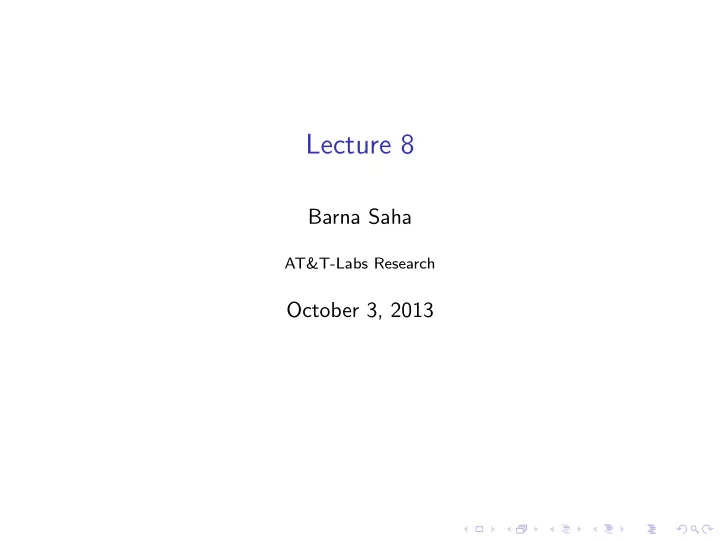

Lecture 8 Barna Saha AT&T-Labs Research October 3, 2013
Outline Clustering K-Center
K-Center ◮ Given a set of distinct points P = { p 1 , p 2 , . . . , p n } find a set of k points Q ⊂ P , | Q | = k , that minimizes max min q ∈ Q d ( p i , q ) i where d is any metric. Suppose the optimal distance is r . If we know r , can find 2-approx in O ( k ) space. Thresholded Algorithm When a new point comes, if the minimum distance of this point from already opened centers is more than 2 r , open a center at that point. Else, assign it to the nearest open center. Can find (2 + ǫ ) approximation in O ( k ǫ log b / a ) space if we know a < r < b Theorem ǫ log 1 (2 + ǫ ) -approximation in O ( k ǫ ) space.
K-Center-Algorithm ◮ Read the first k items in the input. This has error 0. Keep reading the input as long as the error remains 0. ◮ Suppose, we see the first input which causes non-zero error. This gives a lower bound a for r . ◮ Initialize and run the thresholded algorithm for l 0 = a , l 1 = a (1 + ǫ ′ ) , l 2 = a (1 + ǫ ) 2 , ..., l J = a (1 + ǫ ) J = O ( 1 ǫ ). ◮ If the thresholded algorithm declares “FAIL” (tries to open k + 1 centers) for some l i , i ∈ [1 , J ], terminate the algorithm for all l i ′ , i ′ ≤ i . Start running a thresholded algorithm for l i ′ (1 + ǫ ′ ) J +1 for i ′ ∈ [0 , i ] using summarization of threshold l i ′ as the initial input.[Stream-Strapping] ◮ Repeat the above steps until the end of input. At that time report the centers for the lowest estimate for which the thresholded algorithm is still running.
K-center, Sketch Analysis ◮ Suppose end threshold is R and it is updated i times: R 0 , R 0 (1 + ǫ ′ ) J +1 , R 0 (1 + ǫ ) 2( J +1) , ..., R 0 (1 + ǫ ) i ( J +1) ◮ i = 0. Q 1 = P 1 = [ p 1 , p 2 , .., p j ] Error ( Q 1 ) = Error ( P 1 ) ≤ 2 R 0 R 0 OPT ( Q 1 ) > (1 + ǫ ′ ) Error ( Q 1 ) ≤ 2 R 0 ≤ (2 + 2 ǫ ) OPT ( Q 1 ) ◮ i = 1 Q 2 = [ q 1 , q 2 , ..., q k , p j +1 , p j +2 , .., p j ′ ] =, P 2 = p j +1 , p j +2 , .., p j ′ . Terminates with R 1 = R 0 (1 + ǫ ) J +1 R 1 but not with (1+ ǫ ) . Error ( Q 2 ) ≤ 2 R 1 R 1 OPT ( Q 2 ) > 1 + ǫ Error ( Q 2 ) ≤ 2 R 1 = (2 + 2 ǫ ) OPT ( Q 2 )
K-center, Sketch Analysis � P 2 ) and in ◮ Relationships between Error ( Q 2 ) and Error ( P 1 � P 2 ) between OPT ( Q 2 ) and OPT ( P 1 � P 2 ) ≤ Error ( Q 2 ) + Error ( Q 1 ) ≤ 2 R 1 + 2 R 0 = 1 Error ( P 1 � � 1 2 R 1 1 + (1+ ǫ ) J +1 � P 2 ) ≥ OPT ( Q 2 ) − Error ( Q 1 ) ≥ R 1 2 OPT ( P 1 (1+ ǫ ) − 2 R 0 = � � R 1 2 1 − (1+ ǫ ) (1+ ǫ ) J
K-Median r ◮ When we know the optimum solution r : Set f = k (1+log n ) ◮ When considering point x , let δ be the distance to the nearest open center. Open a center at x with probability δ f . Else, assign to the nearest open center.
K-Median Setting the initial estimate Error after reading k + 1th point. How many copies to maintain ? O ( 1 ǫ log 1 ǫ ). But needs O ( 1 ǫ log n ) copies of Stream-Strap to boost the confidence. When to declare an individual estimate is wrong ? If error becomes more than 4(1 + ǫ ) L or open more than k ′ ≃ k log n centers. ǫ ′ Initial Summary k ′ centers weighted by the number of points assigned to those centers. Final Output Run K-median offline algorithm on the selected k ′ weighted centers.
K-Means++ ◮ Extension of K-means clustering: minimizes within cluster sum of squared error. ◮ Initial choice of centers is crucial to guarantee quicker convergence and approximation bound.
Recommend
More recommend